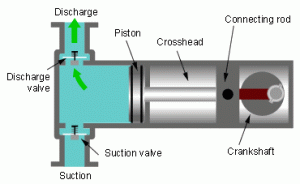Featuring the Air Compressors
Not so long ago a small and portable air compressor could be considered a fantastic innovation, as people had to use huge and heavy centralized systems requiring a lot of space and money. However, nowadays it’s a common tool that can be found in your garage, on the small gas stations, workshops, hardware shops, and even large factories. It’s irreplaceable on any building site because it’s incredibly helpful for powering the pneumatic tools (such as nail guns), which are faster and much more effective than traditional ones. An air compressor is also able to handle spray painting or inflate the tires. Many people simply use it, but seldom question how it’s is made and what the main principles of work it is based on.
The Basic Structure of the Air Compressors
Any air compressor is basically an energy converter that uses a particular power source (it can be electricity, gas, diesel, etc.) and turns it into compressed air stored in the tank of the device. Then this air is transferred into the pneumatic tool you’re working with. So, in fact, air compressors play the role of the transferor of energy from one place to another.
The operating principle of air compressor depends on its particular type. They are of two main kinds: dynamic and positive displacement ones. The former type is divided into the centrifugal, axial, and regenerative air compressors; and the latter one includes reciprocating and rotary categories with each of them having further subdivisions according to the specific features of functioning.
The dynamic or also called “velocity-type” compressors accelerate the air that creates a negative pressure in the inlet port, letting the air in. The air flow partially slows down at the discharge port, turning the kinetic energy into pressure. The pressure change depends on the rotating impeller: the faster is its speed, the higher are pressure differences. The air compressors of this category are often viewed as blowers or fans due to their ability to provide high mass flow rates. According to the direction of the air flow through their compression chambers, dynamic compressors can be centrifugal, axial, and regenerative. However, we’re more interested in the positive displacement air compressors since they are more popular and commonly used.
Unlike the operation of dynamic compressors with the rotating impellers, the positive displacement ones the pressure rise is achieved by decreasing the size of the air-containing chamber. Mostly they perform this operation with the reciprocating piston.
Reciprocating Piston Functions
The reciprocating air compressors can be single and double acting. The basic operation principle is the same in both types. The piston creates the shuttling movement in the cylinder, filling it with air and compressing it. A connecting rod turns the rotary motion of the crankshaft into reciprocating piston movement in the cylinder. Based on a particular application, the rotating crank maintains constant speed by a suitable prime mover. The inlet and discharge valves act according to differences in pressure caused by the piston motion. As the piston reaches the maximum volume position, the inlet valve fills the cylinder with air. As the compression stroke starts, the piston moves in the opposite direction, decreasing the air volume as the piston returns to its minimum position. The difference between the air pressure outside and inside of the cylinder makes the discharge valve open when the piston performs the suction stroke, and close when it starts its return (or compression) stroke.
In general, the reciprocating piston compressors work the best for compression of relatively small volumes of air to high pressures.
Single-acting vs. Double-acting Compressors
The double-acting compressors are based on the same operation principle as the single-acting ones. As the piston goes in a given direction, air is compressed on one side and the suction is created on the other one. During the return stroke, the same thing occurs with the sides reversed. In a single-acting compressor, on the contrary, only one side of the piston is active.
Some of the double-acting compressors are two-stage constructed, which means that the first cylinder is pumping air and delivering it into the second cylinder that provides the pressure rise.
Lubrication Types
The air compressors require lubrication for their components to reduce friction and extend their lifetime. Based on the type of lubricants used, there are oil-lubricated and oil-free compressors.
The oil-lubricated compressors contain a thin film of oil between the moving parts. As the air and oil get partially mixed in the process of compression, the oil contamination can consequently affect many applications. For instance, it’s exceptionally unadvisable for painting or woodworking because it can cause deterioration or stains.
The oil-free compressors are lubricated with “dry” materials like Teflon or graphite instead of oil and don’t require the same level of maintenance as oil-lubricated ones. This type of compressors is a great solution for challenging applications that demand maximum air purity.
The Bottom Line
This information is quite enough if you wanted to get a general idea about the air compressors, their types, and main operation principles they are based on. However, if you do consider buying one of them or search detailed information about some particular models or features of compressors make sure to check out other articles in this respect.
